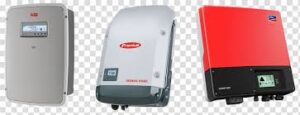Solar panels produce DC electricity, and the inverters convert the DC electricity the solar panels produce into AC electricity we use at homes and businesses. The ratio of DC power connected to an inverter and the maximum amount of AC power an inverter can produce (or inverter rating) is called the DC-to-AC ratio. E.g., When a 12 kWdc solar panel array is connected to a 10 kWac rated inverter, DC-to-AC ratio is 1.2 (12kW/10kW).
 Since solar panels are rated at standard test conditions, solar panels reaching peak power do not occur occasionally under normal operating conditions. Hence, it makes sense to oversize a solar array, compared to inverter rating. It means, the DC capacity divided by the AC rating is greater than one. This results in a greater energy harvest when production is below the inverter’s rating, which typically happens for most of the day.
Since solar panels are rated at standard test conditions, solar panels reaching peak power do not occur occasionally under normal operating conditions. Hence, it makes sense to oversize a solar array, compared to inverter rating. It means, the DC capacity divided by the AC rating is greater than one. This results in a greater energy harvest when production is below the inverter’s rating, which typically happens for most of the day.
However, when the solar array produces the most solar energy at a level higher than the inverter’s power rating, the extra power is “clipped Upgrade ” by the inverter. This is called inverter clipping which ensures the inverter is operating within its capabilities but results in lost energy production during peak production hours. So, when selecting an inverter for a solar power system, it is important to consider how much DC power the solar array will produce and how much AC power the inverter can output.
The maximum oversizing ratio of an inverter depends on number of strings connected the inverter, connected string size, inverter efficiency and factors that affect the inverter’s operating temperature and inverter’s ability to cool, such as shading, mounting and elevation.
The economical limit of oversizing a system can vary, but most projects have the same goal of optimizing the levelized cost of energy. ABB, an inverter manufacturer did a series of studies to find a safe limit for DC-to-AC ratios using its inverters. ABB found that the optimal DC-to-AC ratio in these areas depended on the design goal. For example, regardless of site conditions, sizing a system to maximize specific yield allows for an ideal DC-to-AC ratio at or slightly below 1.2. However, sizing a system to target the best financial output could lead to higher DC-to-AC ratios, between 1.3 and 1.6.
Having a larger array on a fixed-size inverter results in greater annual system production, while fixed system, permitting, interconnection and other costs stay the same, shifting financials in favor of a higher DC-to-AC ratio. Credit:ABB





